
Original Link: https://www.anandtech.com/show/3803/avadirect-clevo-w880cu-fermi-gtx-480m
Fermi Goes Mobile: AVADirect's Clevo W880CU with GTX 480M
by Dustin Sklavos on July 7, 2010 11:45 PM ESTIntroducing the Fermi-in-Your-Backpack
The shell of the Clevo W880CU we're reviewing today probably looks very familiar from Jarred's review of its predecessor, the W870CU, back in September 2009. Sure the red trim has been replaced by a tasteful chrome, and one of the ports is USB 3.0 now, but it's the same Clevo you've all known and... sort of loved.
The basic format hasn't changed at all, although this time the test system came with a 1080p display instead of the HD+ model. (More images of the W880CU are avaialble in our preview.) The LCD is the same high contrast HannStar HSD173PUW1 as the panel in the ASUS G73Jh, so you can read our comments on the panel in that review. The complaints with the W870CU still exist as well—i.e. the crappy keyboard layout on the number pad, and the unwieldy door on the rear of the unit hiding the ports.
What's going to be staggeringly unfamiliar is the new meat sitting inside the W880CU: NVIDIA's new top-end mobile GPU, the GeForce GTX 480M. While we can knock the chassis around again, Clevo is far more interested in being first to market with GTX 480M, and the W880CU does just that. Here are the details of the review system we received from AVADirect, which will make for an interesting comparison against the GTX 285M/HD 5870 notebooks from AVADirect that we reviewed last month.
| AVADirect Clevo W880CU Specifications | |
| Processor | Intel Core i7-820QM |
| (4x1.73GHz, 45nm, 8MB L3, Turbo to 3GHz, 45W) | |
| Chipset | Intel PM55 |
| Memory | 2x2GB DDR3-1333 (Max 2x4GB) |
| Graphics | NVIDIA GeForce GTX 480M 2GB GDDR5 |
| (352 CUDA Cores, 425MHz/800MHz/2.4GHz Core/Shader/RAM clocks) | |
| Display | 17.3" LED Glossy 16:9 1080p (1920x1080) |
| Hard Drive(s) | Seagate Momentus XT 500GB 7200 RPM Hybrid Drive |
| (additional empty bay with RAID 0/1 capability) | |
| Optical Drive | Blu-ray Writer |
| Networking | Gigabit Ethernet |
| Intel Centrino Ultimate-N 6300 (a/b/g/n) | |
| Clevo Bluetooth | |
| V.92 56K Modem | |
| Audio | Realtek ALC888/1200 HD Audio |
| 4.1 speakers with line-in, mic, optical, and headphone jacks | |
| Capable of 5.1 | |
| Battery | 3-Cell, 12V, 48Wh battery |
| Front Side | N/A |
| Left Side | Modem |
| Antenna In | |
| MMC/SD/MS Reader | |
| 4-pin FireWire | |
| 1x USB 2.0 | |
| Optical Drive | |
| Right Side | Headphones, Mic, Line-In, Optical |
| 1 x USB 3.0 | |
| ExpressCard/54 Slot | |
| eSATA | |
| DVI | |
| Kensington Lock | |
| Back Side | HDMI |
| AC Jack | |
| 2 x USB 2.0 | |
| Ethernet | |
| Operating System | Windows 7 Home Premium 64-bit |
| Dimensions | 16.25" x 11" x 1.69"~2.25” (WxDxH) |
| Weight | 8.35 lbs (with 3-cell battery) |
| Extras | Webcam |
| 103-Key keyboard with 10-key | |
| Flash reader (MMC/MS/MS Pro/SD) | |
| USB 3.0 | |
| Bluetooth | |
| Dual drive bays with RAID 0/1 | |
| Warranty | 1-year basic warranty |
| Pricing | $2936.80 as configured from AVADirect |
The Clevo W880CU demands only the briefest of rundowns; the shell is identical (coloring notwithstanding) to the W870CU, and the guts are mostly the same as the W860CU we reviewed recently, though the chassis is slightly larger. Our review unit comes equipped with an Intel Core i7-820QM quad core processor, 4GB of DDR3 (two DIMMs in two slots), and one of those new-fangled Seagate Momentus XT hybrid hard disks.
Oh, and the GeForce GTX 480M. That's what you came here for, right?
The Fastest Mobile GPU in the World: NVIDIA's GeForce GTX 480M
We'll cut to the chase: NVIDIA's GeForce GTX 480M does indeed reclaim the crown of fastest mobile GPU from ATI's strangely anemic Mobility Radeon HD 5870. And it ought to: after all, in a break with tradition the GeForce GTX 480M is actually properly named. The GPU core of the GeForce GTX 480M is indeed a Fermi GF100 lovingly crammed into a notebook form factor. NVIDIA cut that same 3.1 billion transistor you've all come to know and love down to a still-egregious 100-watt TDP, the highest of any mobile graphics hardware to date.
While the GeForce GTX 285M was just another rehash of the G92 and ATI's Mobility Radeon HD 5870 is a mobile version of their desktop Radeon HD 5770, NVIDIA's GTX 480M uses the same cut-down—but still Fermi—core found in desktop GeForce GTX 465 cards. That means 352 of NVIDIA's "CUDA cores" and a 256-bit memory bus connected to GDDR5 memory. The difference is that while the GTX 465 only gets 1GB of GDDR5, the GTX 480M gets a full 2GB in our review notebook. Clock speeds aren't as comparable, though, with the 480M's clock speed down from the GTX 465's 607 MHz to just 425 MHz. The shader clocks get cut down, too, dropping from 1.2 GHz to 800 MHz. Probably the most alarming drop is the GDDR5: running at 3.2 GHz on the desktop card, the 480M has its effective speed cut to just 2.4 GHz, the lowest speed we've ever seen on GDDR5 and actually a slower effective clock speed than the GDDR3 on the desktop GeForce GTX 285!
It's not unreasonable to expect cuts had to be made to fit Fermi into a notebook form factor, but given how underwhelming the performance of the desktop GTX 465 that the GTX 480M borrows its hardware from is, one can begin to become genuinely concerned about NVIDIA cutting too deep to get the GTX 480M to fit into its 100-watt TDP. Both ATI's Radeon HD 5830 and NVIDIA's GeForce GTX 465 have proven that it's possible to hit a wall of diminishing returns when harvesting high-end GPU die; both of these cards are barely faster than their substantially smaller predecessors.
Still, it's impressive Fermi made it into a notebook form factor at all. 352 of NVIDIA's CUDA cores are nothing to sneeze at, and a 256-bit memory interface connected to 2.4 GHz GDDR5 still produces a healthy 76.8GB/sec of bandwidth. The GeForce GTX 480M also brings to the table full DirectX 11 support along with all of NVIDIA's usual trimmings: CUDA, PhysX, and 3D Vision. With Eyefinity largely out of the equation in notebooks, the Mobility Radeon HD 5870 can certianly begin to feel feature light compared to NVIDIA's hardware.
So that's all well and good, but how does the GeForce GTX 480M actually fare in practice?
AVADirect was kind enough to provide us with our testing unit, a specially equipped Clevo W880CU, and a refresher of the notebook's configuration is below:
| AVADirect Clevo W880CU Specifications | |
| Processor | Intel Core i7-820QM |
| (4x1.73GHz, 45nm, 8MB L3, Turbo to 3GHz, 45W) | |
| Chipset | Intel PM55 |
| Memory | 2x2GB DDR3-1333 (Max 2x4GB) |
| Graphics | NVIDIA GeForce GTX 480M 2GB GDDR5 |
| (352 CUDA Cores, 425MHz/800MHz/2.4GHz Core/Shader/RAM clocks) | |
| Display | 17.3" LED Glossy 16:9 1080p (1920x1080) |
| Hard Drive(s) | Seagate Momentus XT 500GB 7200 RPM Hybrid Drive |
| (additional empty bay with RAID 0/1 capability) | |
| Optical Drive | Blu-ray Writer |
| Networking | Gigabit Ethernet |
| Intel Centrino Ultimate-N 6300 (a/b/g/n) | |
| Clevo Bluetooth | |
| V.92 56K Modem | |
| Audio | Realtek ALC888/1200 HD Audio |
| 4.1 speakers with line-in, mic, optical, and headphone jacks | |
| Capable of 5.1 | |
| Battery | 3-Cell, 12V, 48Wh battery |
| Operating System | Windows 7 Home Premium 64-bit |
| Pricing | $2936.80 as configured from AVADirect |
We ran the W880CU through our usual lineup of Futuremark synthetic benchmarks, bouncing between four different versions of 3DMark and two different PCMarks. The matchup you'll want to watch is how the W880CU compares against the W860CUs; these three units are all equipped with an Intel Core i7-820QM processor and 4GB of DDR3, making them fairly ideal comparisons. The only difference that may effect scores is the use of the Corsair Nova SSDs in the W860s.
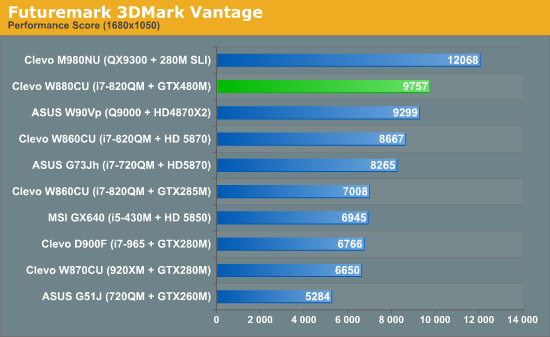
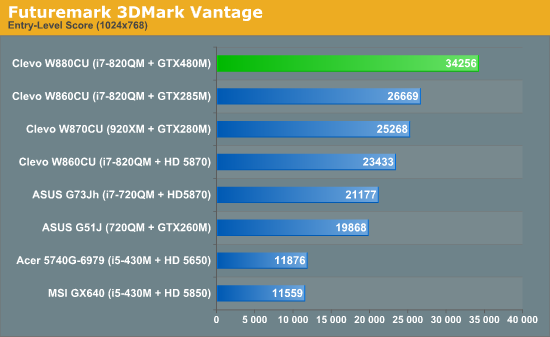
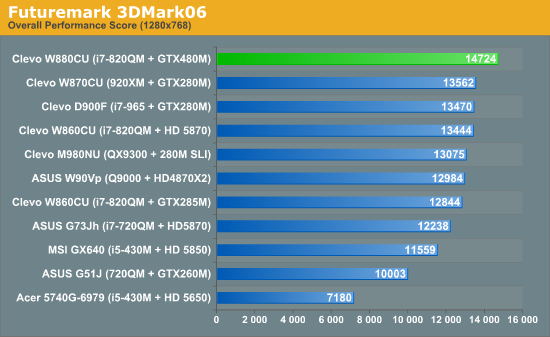
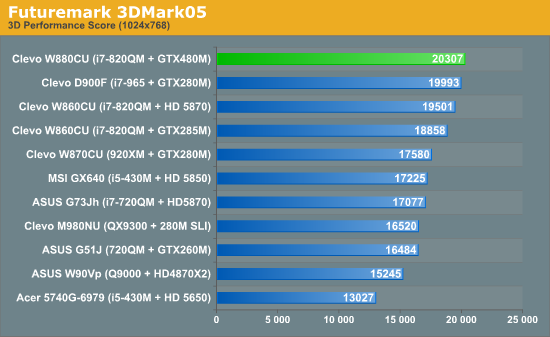
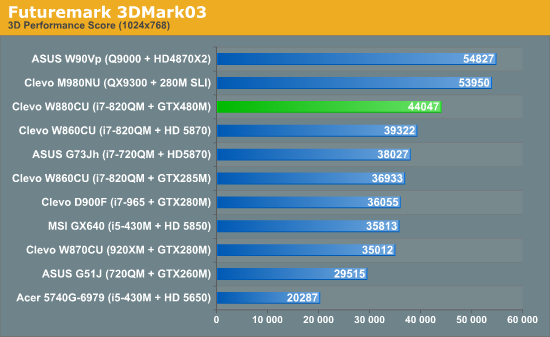
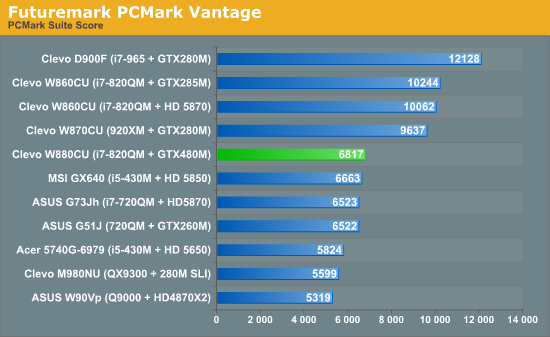
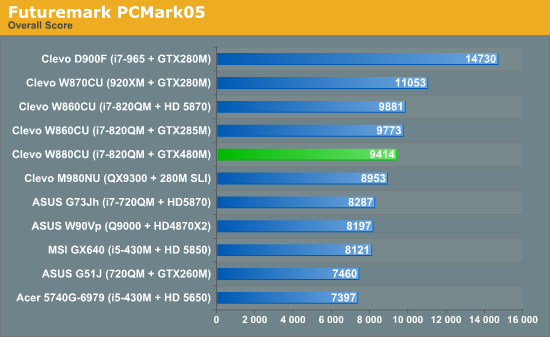
The first thing to notice is that the GeForce GTX 480M takes the W880CU to the top of the class in almost every 3DMark benchmark; in fact, the newer the 3DMark gets, the wider the 480M's lead. The only exceptions are units equipped with dual-GPU solutions. PCMark is much less favorable, but the reduced scores are very likely attributable to the SSDs used in the higher scoring test systems.
So how does the GeForce GTX 480M fare in actual gaming scenarios?
Mobile Gaming Showdown
So we know that as far as 3DMark is concerned, NVIDIA's GeForce GTX 480M is the fastest mobile GPU available. But how does it fare in actual gaming situations?
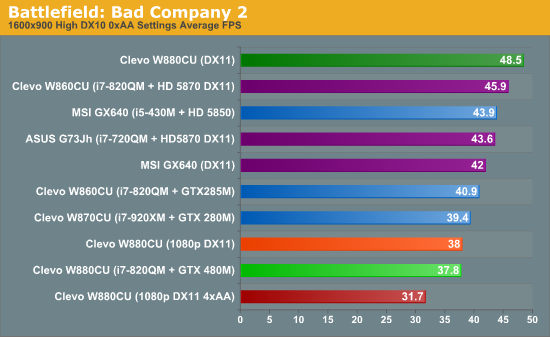
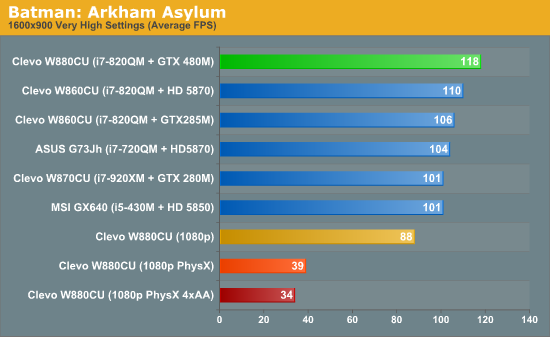
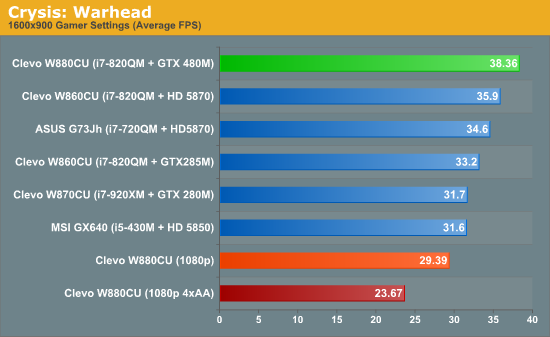
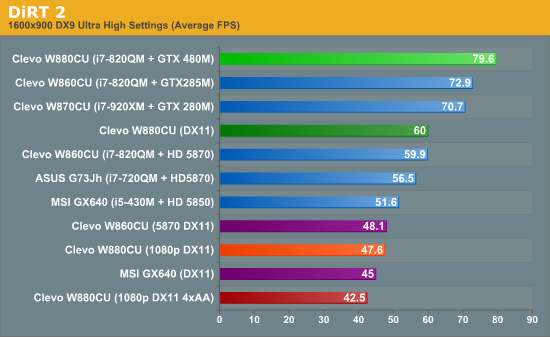
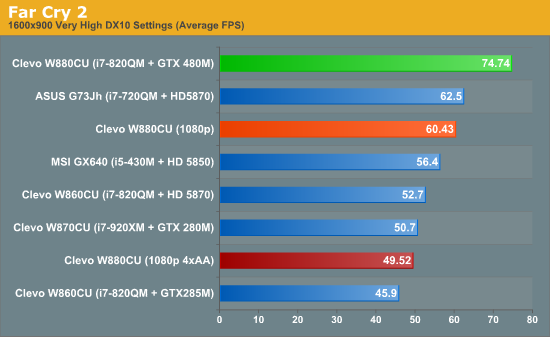
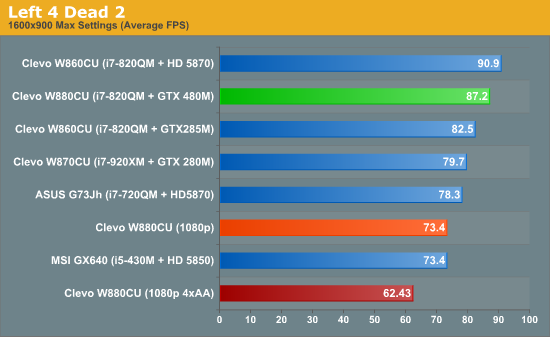
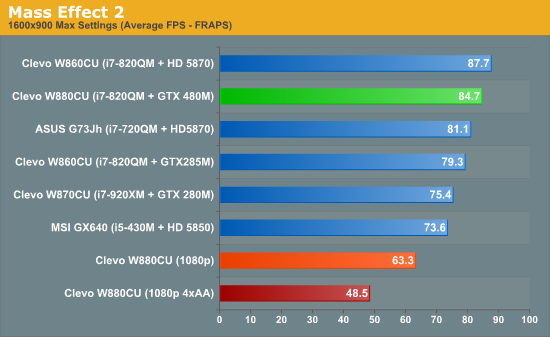
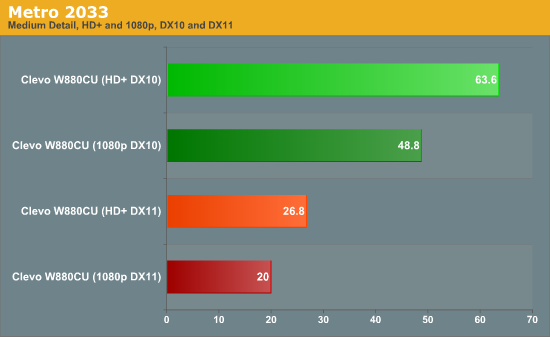
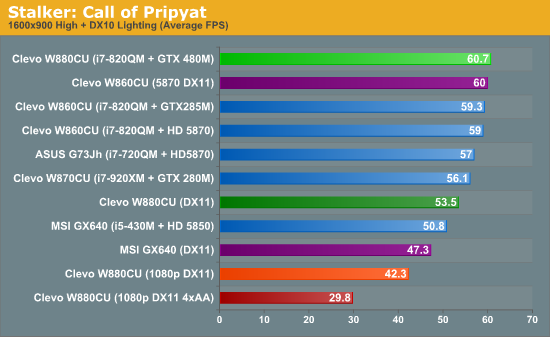
Well, we keep saying it's the fastest mobile GPU available, and that's probably because it's the fastest mobile GPU available. How much faster? That's kind of a problem.
While the 480M takes the lead in most of the games we tested—it downright tears past the competition in Far Cry 2 and DiRT 2—in Mass Effect 2 and Left 4 Dead 2 it was actually unable to best the Mobility Radeon HD 5870. It's only when 4xAA is applied at 1080p that the 480M is able to eke out a win against the 5870 in those titles (we only showed the 4xAA results for the 480M, but you can see the other results in our W860CU review), but the margin of victory is a small one. Of course, Mass Effect 2 doesn't need ultra high frame rates and Left 4 Dead 2 (like all Source engine games) has favored ATI hardware.
Ultimately, that seems to be the pattern here. The wins the 480M produces are oftentimes with the 5870 nipping at its heels; even compared to the 14-in-dog-years GTX 285M it only offers a moderate improvement in gaming performance. What we essentially have are baby steps between top-end GPUs, particularly when we're running DX10 games running at reasonable settings. DX11 titles may be more favorable; DiRT 2 gives the 480M a 25% lead while STALKER is a dead heat; early indication are that Metro 2033 also favors NVIDIA, though we lack 5870 hardware to run those tests. You can see that DX11 mode is punishing in Metro, regardless. Our look at the desktop GTX 480 suggests that NVIDIA has more potent tesselation hardware. Will it ultimately matter, or will game developers target a lower class of hardware to appeal to a wider installation base? We'll have to wait for more DX11 titles to come out before we can say for certain.
NVIDIA provided additional results in their reviewers' guide, which show the 480M leading the 5870 by closer to 30% on average. However, some of those are synthetic tests and often the scores aren't high enough to qualify as playable (i.e. Unigine at High with Normal tesselation scored 23.1 FPS compared to 17.3 on the 5870). Obviously, the benefit of the GTX 480M varies by game and by settings within that game. At a minimum, we feel games need to run at 30FPS to qualify as handling a resolution/setting combination effectively, and in many such situations the 480M only represents a moderate improvement over the previous 285M and the competing 5870. Is it faster? Yes. Is it a revolution? Unless the future DX11 games change things, we'd say no.
Application Performance and Battery Life
Just to be completely safe, we did run an additional three tests to see how the NVIDIA GeForce GTX 480M might affect system performance outside of gaming. The usual suspects were run: Futuremark's Peacekeeper, Cinebench R10, and our x264 video encoding test.
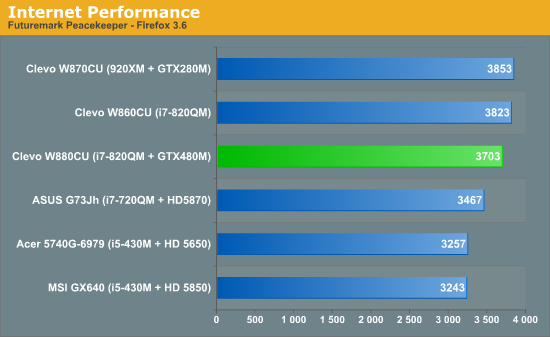
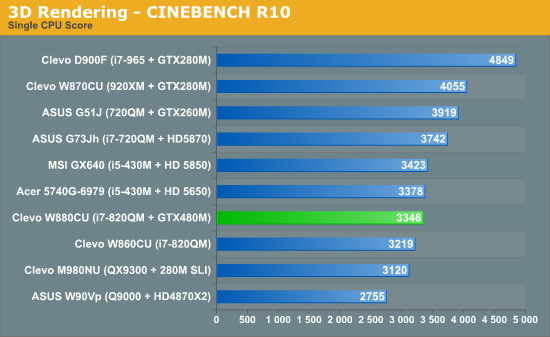
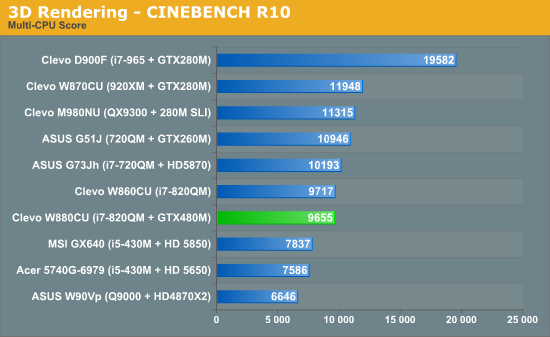
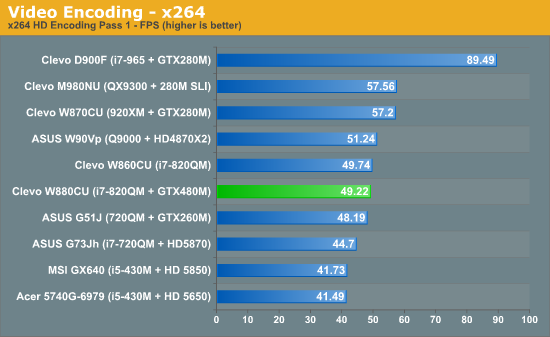
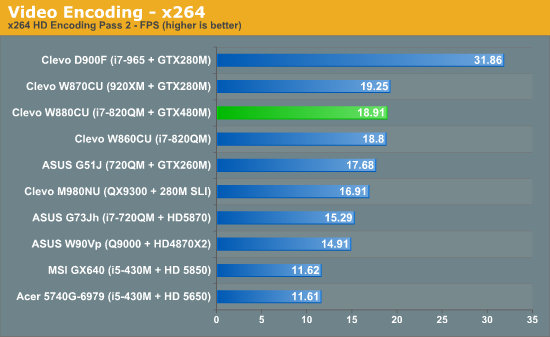
In each situation, the W880CU with its Intel Core i7-820QM falls in line with the previously tested W860CU systems.
We recently had a discussion in our forums that ultimately degenerated a bit into the old NVIDIA vs. ATI war: is NVIDIA hardware a superior option if you'll be using Adobe software? Adobe and NVIDIA both proudly tout increased GPU reliance in Creative Suite 5, culminating in what Adobe calls its "Mercury Playback Engine" in Premiere Pro CS5, a playback system supposedly accelerated by CUDA.
I personally use Premiere Pro and After Effects CS5 for video work on my own desktop, equipped with an ATI Radeon HD 5870, and in none of the CS5 applications have I ever felt like I was missing any secret sauce. It's important to note that features aren't going to be disabled if you aren't running NVIDIA kit, but we figured we'd give the GTX 480M a chance to prove itself in Premiere Pro CS5.
That didn't happen. Presently the 480M isn't supported in CS5; in fact the only NVIDIA hardware supported by the Mercury Playback Engine are the GeForce GTX 285 and several of NVIDIA's expensive workstation-class cards. NVIDIA informs us that other GPUs like the 480M are not supported at launch but Adobe is planning on increasing the number of supported GPUs in the near future. How long that will take is difficult to say (Flash 10.1 took over six months to go from Beta to final release), but at some point in the future Adobe should patch in support for additional NVIDIA hardware. For now, that means we can't make a convincing case for the GTX 480M against the competition if you're going to be using Adobe CS5 software.
If you were looking for a healthy benefit to the 480M, though, you can check out how well it sips power at idle.
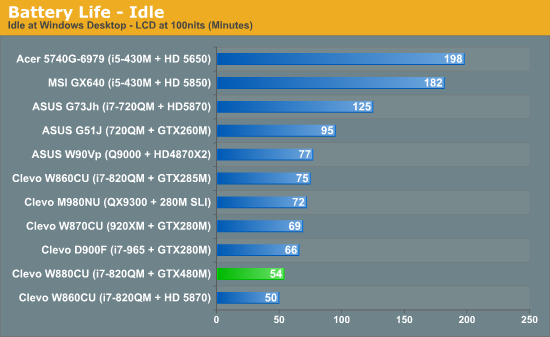
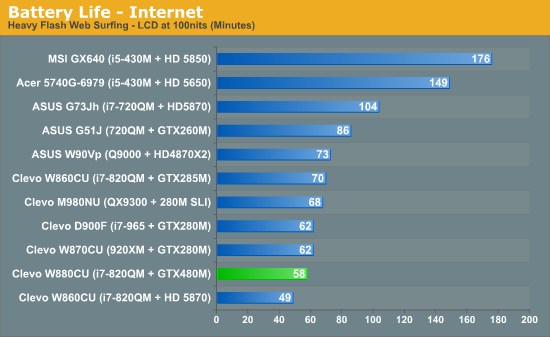
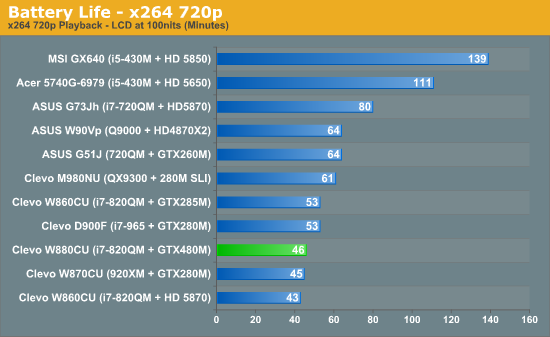
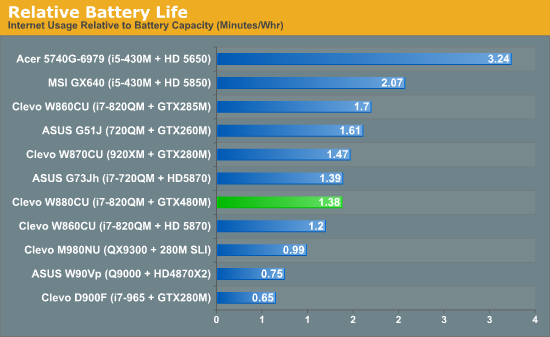
It's true the 3-cell battery in most of these Clevo notebooks is essentially a UPS system, but the ability of NVIDIA's chips to power down so much at idle (ignoring the clear benefits of Optimus in other notebooks) is nonetheless appreciated. The more power a chip draws, the more heat it's liable to produce, and thus the harder the cooling system of the notebook is going to have to work. While you would almost never take this monster off its leash, at least the GTX 480M is pulling its weight by not chugging power from the anemic battery. It essentially matches the ASUS G73Jh in power requirements when unplugged, albeit with a battery that's half the capacity.
Do note that as with other Clevo notebooks, the W880CU will kick the GPU into "limp mode" on battery power, regardless of settings, so you're not going to be playing 3D games at high detail on battery power (for 20 minutes) even if you want to.
GTX 480M: Fast but Mixed Feelings
Back when we took the ATI Mobility Radeon HD 5870 and NVIDIA GeForce GTX 285M and pit them against each other, the 5870's victory was met with some disappointment because it just wasn't the Hail Mary we had hoped for. Notebook graphics performance had been stagnating for so long with no competition at the top of the heap, allowing NVIDIA to refresh the G92 an absurd number of times, and yet when ATI finally decided to come out and play, the best they could do was beat the GTX 285M by about 10% on average. ATI didn't deliver a knockout blow; they just flicked NVIDIA behind the ear over and over again. Now with a cut down Fermi chip powering the GeForce GTX 480M, NVIDIA's response is to say "quit it!" and slap at ATI's hands.
The most impressive thing about the 480M isn't its performance; it's the fact that NVIDIA was able to get the sucker into a notebook to begin with. Sure, it's a nine pound notebook cooling a TDP of 100 watts, but credit where credit is due: Fermi isn't exactly well known for being economical with power on the desktop. Really, the GTX 480M raises more questions than it answers.
I suspect most of us agreed when the GeForce GTX 260 and GTX 280 came out that there was no way NVIDIA would ever fit those chips in a notebook, and in some sense we were proven right with refresh after refresh of G92 at the top of the mobile graphics food chain. With mobile Fermi, it looks like NVIDIA more likely chose to remain with a tweaked G92 in order to focus resources elsewhere—i.e. dropping to 55nm to save power and boost clocks over the 65nm original. Obviously, we wouldn't have wanted a trimmed down GT200 chip this late in the game, but cutting down the GF100 to fit into a notebook had to have been far more onerous a task than trying to get a 55nm GT200b die into the same power envelope (or trying to respin GT200b at 40nm). Unfortunately, GT200b doesn't have DX11, so really NVIDIA had no choice. The result is a GF100 die that sips power at idle (relatively speaking) but still guzzles the juice under load. (Not that you'd run a gaming laptop on battery power.)
As for ATI/AMD, they seemed unable to deliver Mobility Radeon HD 4800s in any kind of reasonable quantities, and in general there was a lack of interest. Contrast that against being able to buy an HD 5800 series laptop from a variety of vendors today. They're not the fastest mobile parts any longer, but they are far more affordable. $1500 for the ASUS G73Jh makes the Clevo W880CU look like highway robbery! Go one step further and start asking ATI the same questions. Cypress is a monster to be sure, but it's no more a beast in terms of power and heat than its predecessors, the RV770 and RV790, were. RV770 made it into notebooks, but the best ATI says they can do is trim the clocks on Juniper and call it a day. We're left with a Mobility Radeon HD 5870 that offers a minimal improvement on its predecessor and wondering why a mobile chip based on the superbly economical Radeon HD 5850 isn't making the rounds. If NVIDIA can do a 100W TDP mobile part, AMD should be able to do the same. Certainly trimming Cypress too much has proven in some ways as troublesome as cutting down Fermi has been; the 5830 sports higher thermals and power draw than the 5850, and the GTX 465 landed on the market with a resounding thud, but desktop parts aren't the same battleground as notebooks and 5830 or GTX 465 levels of performance in a notebook would be substantially faster than what we currently have.
Really, NVIDIA got to sit on the top of the mobile GPU heap for far too long. It's good to see competition, and we can only hope that there's more to come from both companies. We're still a generation behind in terms of desktop performance; even if both companies are now using up-to-date parts, the final clock speeds are a far cry from desktop GPUs. What we really want is more of a Conroe style revolution for mobile GPUs where we get up to 25%-50% more performance without increasing power requirements—or even reducing them!—over last generation hardware. Then again, the P4 architecture was so poor that it made Conroe possible.
It's hard to believe there aren't better options for either manufacturer. Was NVIDIA so upset about losing the mobile crown to ATI—even though the margin wasn't that great to begin with—that it was worth curtailing Fermi's performance so brutally? Wouldn't the prudent thing to do have been to let ATI have their cake for the time being and try and push GF104 into laptops? Or would that just be suggesting NVIDIA do the same thing we're accusing ATI of? Like we said, the GeForce GTX 480M raises more questions than it answers, but all of us armchair engineers have to be wondering why mobile graphics aren't improving faster.
Looking at the big picture, the limiting factor on mobile GPUs is power. Desktop cards keep getting faster, sure, but power requirements are generally increasing as well. ATI's 4870 has higher load power than 3870, and 5870 leapfrogs 4870. Likewise, NVIDIA's GTX 285 needed more than the 9800 GTX, and the GTX 480 ups the ante. Move over to notebooks, and we hit the power wall hard. The biggest power bricks are still 240W (give or take), so there's no going over that limit, even if you can dissipate the heat. We've had the same 220-240W power adapters at the high-end for years, and it doesn't look to be changing. 480M may have bumped the TDP up to 100W, but our battery life tests show that it's about the same as the 50W 5870 when it's not under load, and we've had dual-GPU notebooks that use a lot more power than a single 480M. It's not like you're going to load the GPU without plugging in, and at that point it's more a question of whether cooling is sufficient than how much power you need.
Perhaps a simpler way of stating things is that mobile graphics performance isn't increasing very quickly. AMD likely took the existing GTX 285M and did enough testing and research to make sure 5870 was faster by 10%. Now NVIDIA has gone and done the same thing to regain the lead. They pushed the power envelope harder, but that's more a factor of the Fermi design constraints right now. Give them time for revisions and we'll likely see that drop. Ultimately, process technology refinements and tweaked architectures are the primary means of performance improvements, and 25% faster per year looks to be the goal.
Closing Thoughts
The back to school season is starting to gear up, and we should see more DX11 GPUs out of NVIDIA using something besides a trimmed GF100 in the fall. We also hope to see better designs using the GTX 480M, because frankly the W870CU/W880CU chassis is not what we expect from a high-end gaming notebook. Perhaps we'll even see some ambitious company stuff a couple GTX 480M chips into a notebook, though we'll need more than a 240W power brick to make that happen. Naturally, there should be plenty of competition from the AMD camp as well, and if nothing else at least 480M has made things interesting.
At the end of the day, NVIDIA got their crown back. The GeForce GTX 480M is now officially the fastest mobile GPU available, and like the AMD camp it supports DX11. Beyond being faster than the HD 5870, you also get CUDA and PhysX support. Was it worth it? It depends on your perspective.
If NVIDIA could get the GTX 480M clocks up about 30% without increasing power, this would be a monster. But what we really need is a SKU from a vendor that doesn't milk people for every dollar. If we're aggressive on other components we can get the W880CU down to around $2300 with 4GB RAM and a Core i5-520M, and that should still be fast enough to feed the GTX 480M. Do the same for the W870CU with HD 5870 and you can get the price down to $1600... or just grab the ASUS G73Jh for $1500 and get a backpack, larger battery, 8GB RAM, and dual 500GB hard drives. Small wonder the ASUS G73Jh continues to be our pick for a DTR gaming laptop. Hopefully ASUS or someone else can do a similar treatment for the 480M, because right now the W880CU just isn't worth buying.
Now, if someone can get us close to 5870/480M performance and features and throw in Optimus Technology (or an AMD equivalent) with a reasonable chassis and battery life, we'd be far more interested. Think Alienware M11x with a slightly larger chassis and a faster CPU/GPU, ASUS U30Jc with a faster DX11 GPU, or the MSI GX640 with a better keyboard and auto-switching graphics. Is anyone crazy enough to try an Arrandale CPU with GTX 480M and Optimus for under $2000? We can only hope! (Or we can wait for Intel to get quad-core Sandy Bridge CPUs with IGPs next year.) Many laptops are coming close, but so far we haven't encountered anything that we can universally recommend. Perhaps the inevitable fall refresh will have what we're looking for.
We'd also like to thank AVADirect for providing us with our Clevo W880CU Gaming Notebook review sample.













